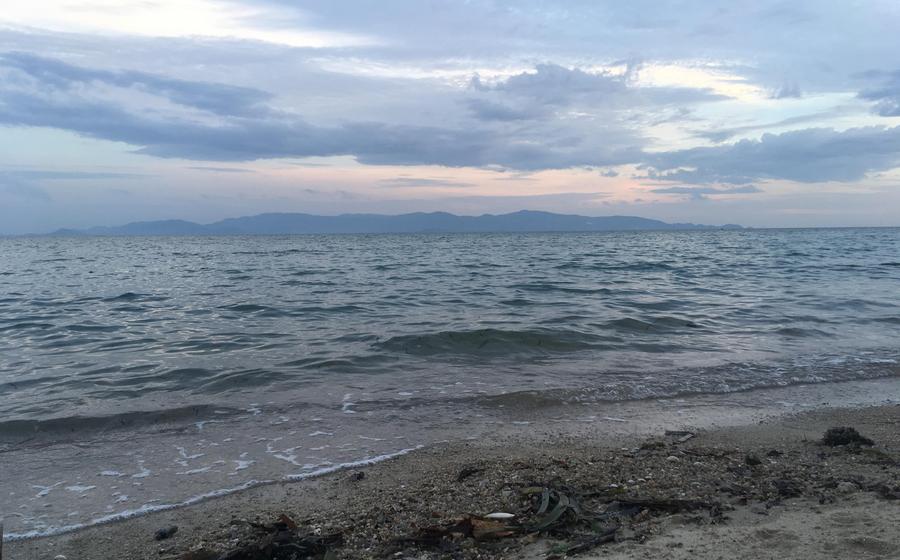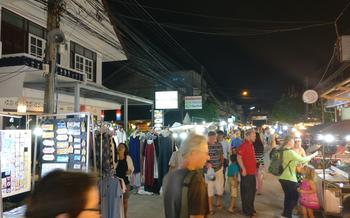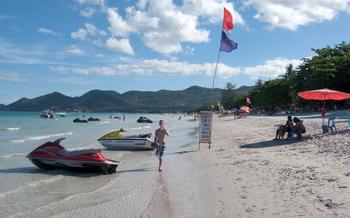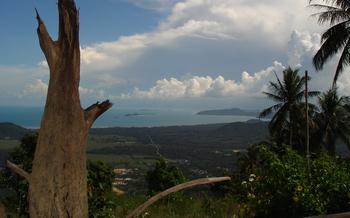
Khao Hua Jook Pagoda
- Location and Accessibility
- Climbing the Pagoda
- Panoramic Views from the Top
- The Grand Buddha Statue
- Temple Grounds and Surroundings
- Local Culture and Traditions
- Offerings and Donations
- Visiting Hours and Admission
- Photography and Social Media
- Accommodation and Dining Nearby
- Combining with Other Attractions
- Ethical Tourism Practices
- Solo Travel and Group Tours
- Insider Tip: Hidden Gem
Location and Accessibility
The Khao Hua Jook Pagoda is strategically positioned, offering easy access to other popular attractions on Ko Samui. Its central location in the island's mountainous region makes it a convenient stop while exploring the island's natural wonders and cultural heritage.
Proximity to other attractions: The pagoda is in close proximity to several other must-visit destinations. The pristine beaches of Lamai and Chaweng are a short drive away, inviting visitors to indulge in sun-soaked relaxation and water sports. For those seeking a spiritual journey, the revered Wat Phra Yai (Big Buddha Temple) is just a few kilometers away, showcasing a colossal golden Buddha statue that exudes tranquility and reverence.
Transportation options: Reaching the Khao Hua Jook Pagoda is a breeze, with multiple transportation options available. Visitors can rent a car or motorbike to enjoy the freedom of exploring the island at their own pace. Public transportation, including buses and songthaews (shared taxis), is also readily accessible, providing a budget-friendly alternative.
Parking availability: Ample parking space is available at the base of the pagoda, ensuring a hassle-free visit for those arriving by car or motorbike. The parking area is well-maintained and secure, providing peace of mind to visitors.
Guided tours: For those who prefer a guided experience, organized tours are available that include a visit to the Khao Hua Jook Pagoda. These tours typically encompass other popular attractions, offering a comprehensive exploration of the island's highlights.
Climbing the Pagoda
Ascending the Khao Hua Jook Pagoda is a physically challenging yet rewarding experience that unveils breathtaking panoramas of Ko Samui. The pagoda comprises 152 steps, each adorned with intricate carvings and offering a unique perspective of the surrounding landscape. While the climb may require some effort, it is suitable for individuals of varying fitness levels. Resting points along the way provide opportunities to catch your breath, hydrate, and admire the scenery.
For safety reasons, handrails are installed alongside the staircase, ensuring a secure ascent and descent. Additionally, the steps are well-maintained, minimizing the risk of slipping or stumbling. It is advisable to wear comfortable shoes with good traction, as the surface can become slippery during wet weather.
Panoramic Views from the Top
As you ascend the Khao Hua Jook Pagoda, the breathtaking vistas of Ko Samui gradually unfold before your eyes. Reaching the summit, you will be rewarded with a truly panoramic experience. The entire island lies at your feet, an emerald gem set against the azure backdrop of the Gulf of Thailand. The undulating hills and lush rainforests that characterize Ko Samui's landscape stretch out in all directions, creating a mesmerizing tapestry of nature's artistry.
In the distance, the shimmering turquoise waters of the sea meet the horizon, where tiny sailboats and fishing boats dot the coastline. On a clear day, you can even catch glimpses of neighboring islands, such as Koh Phangan and Koh Tao, rising out of the ocean like mystical silhouettes.
The pagoda offers multiple viewing platforms, allowing you to soak in the scenery from different angles. Find a spot to sit and savor the tranquility of the moment, letting the gentle breeze caress your skin as you marvel at the panoramic beauty that surrounds you.
As the sun begins to set, the sky transforms into a canvas of vibrant hues, casting a golden glow over the landscape. This is a magical time to visit the pagoda, as the colors of the sunset blend seamlessly with the panoramic views, creating a truly unforgettable spectacle.
Sunrise is another special time to experience the pagoda's vistas. As the first rays of light peek over the horizon, the island awakens from its slumber, and the air fills with the sounds of birdsong and the gentle lapping of waves against the shore. The rising sun illuminates the pagoda, casting long shadows that dance across the surrounding grounds, adding an ethereal quality to the scene.
Whether you visit at sunset, sunrise, or any time in between, the panoramic views from the top of the Khao Hua Jook Pagoda are sure to leave you spellbound. Don't forget your camera to capture these stunning vistas and share them with the world.
The Grand Buddha Statue
At the summit of Khao Hua Jook, visitors are greeted by the majestic sight of the Grand Buddha statue, exuding an aura of serenity and spirituality. This colossal statue, standing tall at 12 meters, is not only a testament to the artistry and devotion of the Thai people but also holds significant religious and symbolic value.
Crafted from gleaming white marble, the Grand Buddha embodies the essence of compassion and wisdom, its benevolent gaze radiating peace and tranquility. The statue's intricate detailing and graceful posture reflect the exceptional craftsmanship and deep reverence of its creators.
Beyond its aesthetic beauty, the Grand Buddha carries profound religious significance. Depicting the Buddha in a seated meditation pose, with his right hand raised in the gesture of reassurance and protection, the statue serves as a poignant reminder of the Buddha's teachings on enlightenment and the path to liberation from suffering.
Devotees and visitors alike pay homage to the Grand Buddha by offering flowers, incense sticks, and candles at its base. These offerings, imbued with prayers and aspirations, symbolize gratitude, devotion, and the seeking of blessings. The act of making offerings is believed to accumulate merit, a key concept in Buddhist teachings that contributes to a better rebirth and spiritual progress.
For those seeking a deeper spiritual connection, the Grand Buddha provides a serene and conducive environment for meditation and contemplation. The statue's presence encourages introspection, invites reflection on the nature of existence, and fosters a sense of inner peace and tranquility.
Temple Grounds and Surroundings
The temple grounds surrounding the Khao Hua Jook Pagoda exude a serene and sacred atmosphere, inviting visitors to immerse themselves in the tranquility of the Buddhist faith. Prayer flags flutter gently in the breeze, creating a symphony of colors and sounds that add to the spiritual ambiance. Buddha images and shrines are scattered throughout the grounds, providing opportunities for reflection and meditation. The serenity and tranquility that permeate the air create a sanctuary where visitors can find respite from the bustling world outside.
Local Culture and Traditions
When visiting the Khao Hua Jook Pagoda, it is crucial to be mindful of local customs and traditions to show respect and understanding for Thai culture. Respectful behavior and etiquette are highly valued. Avoid loud noises, refrain from pointing your feet at Buddha images, and remove your shoes before entering temples or sacred areas.
Dress modestly with covered shoulders and knees when visiting religious sites. Buddhist customs and practices are deeply ingrained in Thai society. Learn about the significance of offerings, such as flowers, incense, and candles, and the practice of merit-making, where devotees offer donations to earn good karma.
Be aware of Buddhist festivals and ceremonies, such as the annual Loi Krathong festival, where people release floating lanterns into the sky. Participating in these events can provide a unique insight into Thai culture.
Offerings and Donations
Making offerings and donations at the Khao Hua Jook Pagoda is a significant part of the religious and cultural experience. These offerings are a way to show respect and gratitude to the Buddha, as well as to seek blessings and good fortune.
The most common types of offerings include flowers, incense, and candles. Flowers symbolize purity and beauty, while incense represents prayers and devotion. Candles signify wisdom and enlightenment. Visitors can purchase these offerings from vendors near the pagoda or bring their own.
Donation boxes are also located throughout the temple grounds, where visitors can make monetary offerings. These donations are used to support the upkeep of the pagoda and to fund various temple projects. Making a donation is considered a meritorious act that brings good karma and blessings.
In addition to material offerings, visitors can also offer their time and energy by participating in volunteer activities at the pagoda. This could involve helping with cleaning, gardening, or other maintenance tasks. Volunteering is a meaningful way to give back to the temple community and to earn merit.
By making offerings and donations, visitors can contribute to the preservation of this sacred site and show their respect for the Buddhist religion. These acts of generosity are believed to bring blessings and good fortune to both the giver and the recipient.
Visiting Hours and Admission
The Khao Hua Jook Pagoda is open to visitors daily from 8:00 AM to 6:00 PM. Admission is free of charge, allowing everyone to experience the spiritual and cultural significance of the temple without financial barriers.
Best Time to Visit: To avoid the midday heat and crowds, consider visiting the pagoda early in the morning or late in the afternoon. During these times, you'll have the chance to enjoy the peaceful atmosphere and stunning views without the hustle and bustle of large tourist groups.
Seasonal Variations: The pagoda is accessible year-round, but the weather conditions can vary depending on the season. In the rainy season (May to October), expect occasional showers, while the dry season (November to April) offers warm and sunny days. Plan your visit accordingly to make the most of your experience.
Photography and Social Media
The Khao Hua Jook Pagoda is a captivating subject for photography enthusiasts, offering breathtaking vistas and unique cultural elements. Capture the beauty of the pagoda's intricate architecture against the backdrop of the lush surroundings. Remember to be respectful of the religious significance of the site and refrain from using flash photography inside the temple.
Share your experiences on social media to inspire others to embark on their journey to this hidden gem. Use relevant hashtags like #KhaoHuaJookPagoda, #KoSamui, and #Thailand to connect with like-minded travelers and showcase the pagoda's allure to the world. Geotagging your photos will help others easily locate this stunning destination.
Accommodation and Dining Nearby
Ko Samui offers a wide range of accommodation options to suit all budgets and preferences. From luxurious resorts with private beaches and spas to budget-friendly guesthouses and hostels, there is something for every traveler. For those seeking a truly unique experience, there are also several treehouse and jungle bungalows available.
In terms of dining, Ko Samui boasts a diverse culinary scene with something to satisfy every palate. From traditional Thai cuisine to international flavors, there are countless restaurants, cafes, and food stalls to choose from. For those on a tight budget, there are many affordable options, such as street food vendors and local markets where you can sample delicious dishes at a fraction of the cost.
For those seeking vegetarian or vegan options, Ko Samui also has several restaurants and cafes that cater to this dietary preference. These establishments offer a variety of plant-based dishes, from fresh salads and curries to vegan burgers and desserts.
If you are looking for a more immersive culinary experience, consider taking a cooking class and learning how to prepare traditional Thai dishes using fresh local ingredients. This is a great way to not only learn about Thai culture but also to bring home some new culinary skills.
Combining with Other Attractions
Ko Samui offers a plethora of attractions, making it easy to combine a visit to the Khao Hua Jook Pagoda with other enriching experiences. Nearby Beaches and Swimming Spots: Indulge in the sun, sand, and sea at some of Ko Samui's pristine beaches, such as Chaweng Beach, Lamai Beach, or Bophut Beach. Nature Parks and Hiking Trails: Explore the island's lush nature parks, including the Ang Thong National Marine Park with its stunning limestone karsts, or embark on a rejuvenating hike through the scenic trails of the Samui Elephant Sanctuary. Cultural and Historical Sites: Discover Ko Samui's rich history and culture at attractions like the Big Buddha Temple, the Fisherman's Village, or the Ko Samui National Museum. Island Hopping Excursions: Embark on a thrilling island-hopping adventure to neighboring islands like Koh Phangan, Koh Tao, or Koh Nang Yuan, each offering unique experiences and breathtaking sights.
Ethical Tourism Practices
As you embark on your journey to the Khao Hua Jook Pagoda, it is crucial to embrace ethical tourism practices to ensure the sustainability and respect for the local culture and environment. Here are some key considerations:
-
Support Local Businesses: Choose to stay in locally-owned guesthouses or hotels, dine at authentic Thai restaurants, and purchase souvenirs from local artisans. This not only supports the local economy but also preserves the unique character of the island.
-
Respect the Environment: Minimize your ecological footprint by reducing plastic waste, opting for eco-friendly transportation options, and avoiding activities that harm the natural surroundings. Respect the designated trails and refrain from disturbing wildlife.
-
Avoid Disrespectful Behavior: Remember that the pagoda is a sacred site for Buddhists. Dress modestly, maintain a respectful demeanor, and refrain from loud or disruptive behavior. Photography is permitted, but be mindful of the privacy of others and avoid taking pictures of individuals without their consent.
-
Preserve the Sacredness of the Pagoda: Refrain from climbing or touching the Buddha statues or any religious objects. Respect the offerings left by devotees and avoid disturbing the serenity of the temple grounds. By practicing ethical tourism, you contribute to the preservation of the pagoda's spiritual significance and ensure a positive experience for all visitors.
Solo Travel and Group Tours
Whether you're a solo traveler or part of a group, visiting the Khao Hua Jook Pagoda offers a unique and enriching experience. Solo travelers can immerse themselves in the serenity of the temple grounds, taking time to reflect and connect with their inner selves. The pagoda's peaceful atmosphere and welcoming locals create a safe and supportive environment for solo adventurers.
Group tours are an excellent option for those seeking a more structured and informative visit. Local guides can provide insights into the pagoda's history, cultural significance, and religious practices. Group tours often include transportation to and from the pagoda, ensuring a hassle-free experience.
Meeting fellow travelers is easy at the Khao Hua Jook Pagoda, as the site attracts visitors from all over the world. The shared experience of climbing the pagoda and taking in the panoramic views fosters a sense of camaraderie among travelers. Exchanging stories and travel tips with fellow adventurers can enhance the overall experience.
Safety considerations for solo travelers should include being aware of your surroundings, dressing respectfully, and avoiding isolated areas. Group tours provide an added layer of security, as you'll be accompanied by a guide and fellow travelers.
Insider Tip: Hidden Gem
Beyond the main tourist trail, there's a hidden gem waiting to be discovered. A short walk from the Khao Hua Jook Pagoda, nestled amidst lush greenery, is a secluded viewpoint that offers a breathtaking panorama of Ko Samui. This spot is ideal for those seeking tranquility and a deeper connection with nature.
As you venture off the beaten path, the sounds of the city fade away, replaced by the gentle rustling of leaves and the chirping of birds. The path leads you to a clearing, where a wooden bench awaits, inviting you to sit and soak in the beauty that unfolds before you.
From this vantage point, you'll witness a mesmerizing tapestry of colors as the sun dips below the horizon, casting a golden glow over the island. The silhouette of neighboring islands fades into the distance, creating a picturesque backdrop for your moment of serenity. Embrace the tranquility of this hidden gem, let your worries melt away, and immerse yourself in the magic of Ko Samui.






